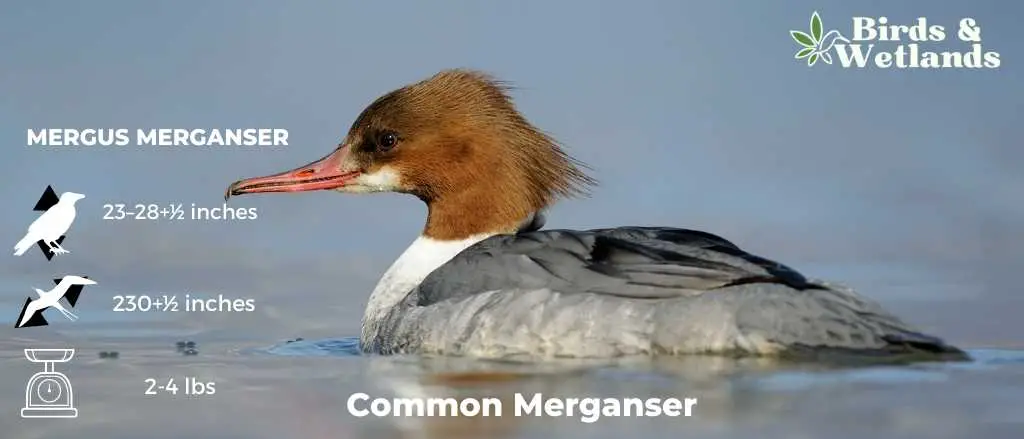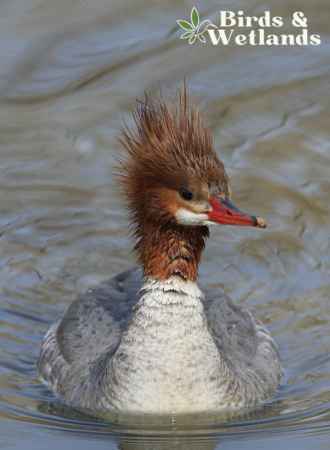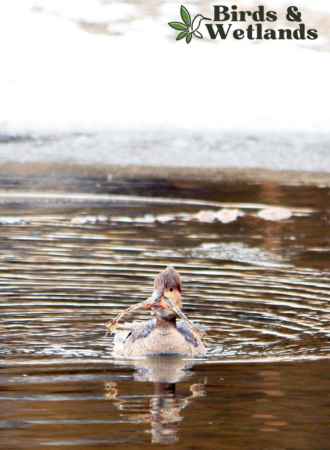
The common merganser, also known as the goosander in Europe, is a large sea duck belonging to the taxonomic family of Anatidae.
It has three recognized subspecies which include M. m. merganser, M. m. americanus and M. m. Orientalis. All of them have similar physical features with some minor differences.
The common merganser can be found throughout North America, Europe and Asia, inhabiting coasts near woodlands or forests, freshwater rivers and lakes, where they feed mainly on fish, crustaceans, amphibians and freshwater invertebrates like insect larvae, among other things.
Scientific Name: Mergus merganser
Length: 58–72 cm (23–28+1⁄2 in)
Wingspan: 78–97 cm (30+1⁄2–38 in)
Weight: 0.9–2.1 kg (2 lb 0 oz – 4 lb 10 oz)
Physical Description

Adult male common mergansers in breeding plumage have a black head with iridescent green gloss, white lower neck and breast, black back and red bill with a black nail. The variable salmon-pink tinge shown by some males is most likely due to its diet.
Females and juveniles have a similar overall body shape and size as adult males, but their coloring is generally more subdued. They have a reddish-brown head and upper neck, and largely grey body plumage. They also have white secondary feathers on the wings and longer head feathers on the crest.
Large white patches on the upperwings are visible while both genders are in flight.
Males in non-breeding plumage in the late summer to mid-autumn have a similar appearance to females.
Listen to the Common Merganser
Distribution & Range

The common merganser is a duck species widely distributed across the northern hemisphere. It has three subspecies found in different parts of the world.
M.m. merganser occurs in the Palaearctic region. Western European birds are mostly residents and are short-distance migrants.
M.m. orientalis inhabits Central Asian mountains, Tibet and the Himalayas, and western China.
M.m americanus can be found throughout North America and Canada. Eastern North American birds travel south in small groups to the shores of the milder Pacific coast or areas where ice-free conditions exist when breeding areas where large rivers and major lakes freeze during cold winter months.
It has been observed that adult males winter farther north than adult females and young birds.
Habitat
The common merganser is well-adapted to various habitats, although they prefer fresh water all year round.
During the breeding season, these birds inhabit freshwater lakes and pools and the upper reaches of rivers with close trees nearby. These areas provide the necessary resources for the birds to successfully raise their young, including access to food and shelter.
When the winter season arrives, common mergansers typically migrate to near large lakes and rivers where the water remains unfrozen. They may also be found in lagoons and brackish marshes during this time, although they are less common in these habitats.
While they are not typically found on the coast, it is not uncommon for a small number of individuals to winter near saltwater estuaries.
Feeding Habits & Diet

The common merganser is a sea duck that feeds on small fish fry, aquatic invertebrates, small mammals and plants.
Common mergansers forage in clear aquatic habitats, such as streams, rivers, lakes, coastal bays, and estuaries, using their sight and long, serrated bills to capture prey from the water’s surface or depths. They swim deep and float downstream or commonly fish their way back, diving continuously the entire time.
Young birds eat mostly aquatic insects but will learn how to catch fish after a week or two.
Nesting & Mating Habits

The common merganser is found throughout the Northern Hemisphere’s temperate regions. These birds are known for forming pairs during the winter and breeding from late spring to early summer when food sources are more abundant.
These birds may solitarily or in large colonies. One or more birds will stand guard nearby to alert the flock of potential danger.
Common mergansers typically build their nests near water sources, such in a large tree cavity, rock crevices, holes under tree roots, or even large nest boxes hidden among riverbank vegetation. The nests are made of wood chips and debris with a down lining to keep the eggs safe and warm.
The average clutch size for these birds is 8 to 13 yellowish eggs. It is not uncommon for females to lay eggs in each other’s nests when they find an existing nest to use. The incubation period for common mergansers is 30-35 days, and the female alone incubates the eggs.
Males leave the nesting area as soon as the young hatch to molt. Hours after hatching, the young jump out of the cavity and into the water. In some cases, the mother takes her young on her back to rivers or lakes immediately after hatching.
Threats & Conservation
The common merganser is widely distributed across Europe, Asia, and North America. It is currently assessed as Least Concern by the IUCN due to its large population size and wide range. However, the species still faces threats from habitat loss, pollution, and hunting pressure in some areas.
Hunting
Hunting regulations for common mergansers in the United States vary by state and are subject to several limitations. In many states, for instance, only a certain number of birds can be taken each season, as set by the respective state fish and wildlife department.
Some states may also limit the size or sex of birds that can be taken during the season, with larger males often restricted from hunting due to their significance in passing down genes.
Key Points
- The common merganser is a fish-eating duck that eats mostly fish and other aquatic prey.
- The breeding habitat of the common merganser is found in forested areas with many trees and water access.
- The young feed by dabbling but will learn how to dive after a week or two.
- Common mergansers build their nests inside tree cavities in northern forests.
- These ducks live near fresh water rivers and lakes.
